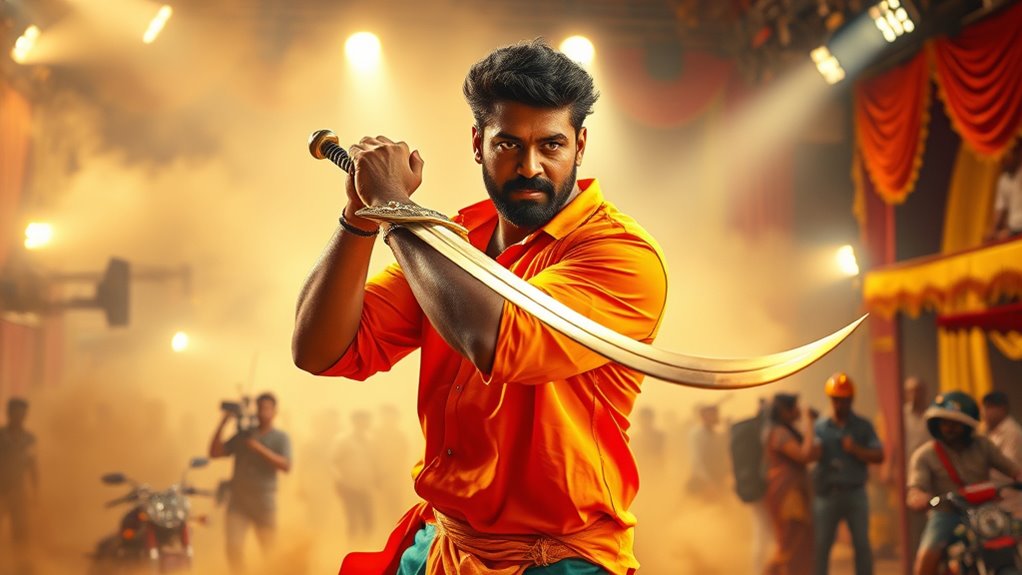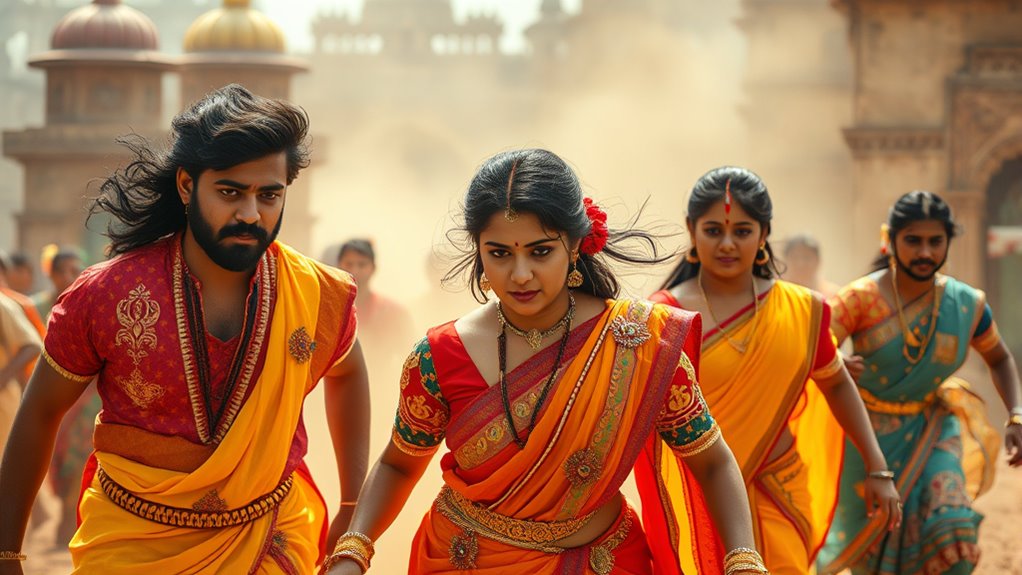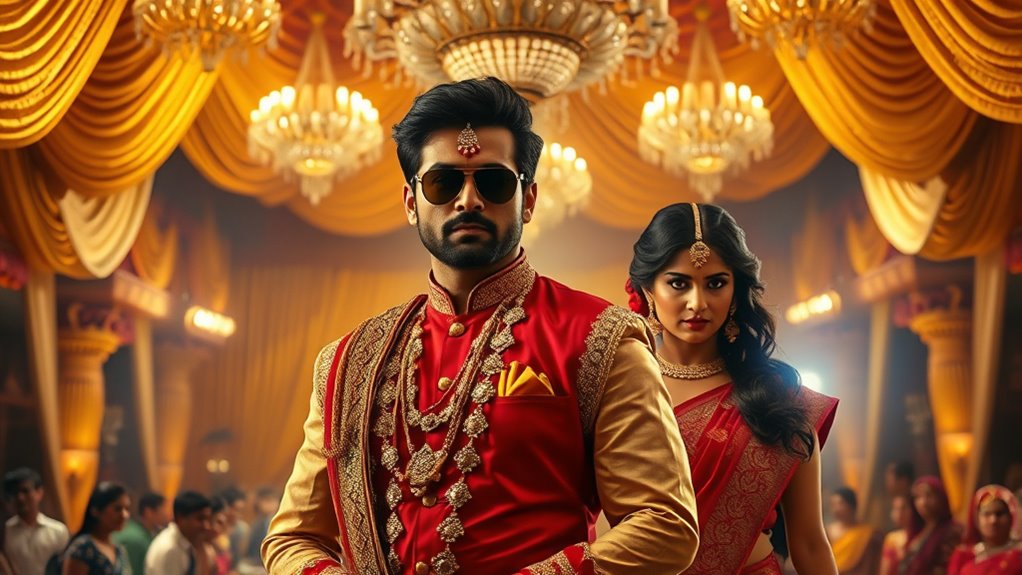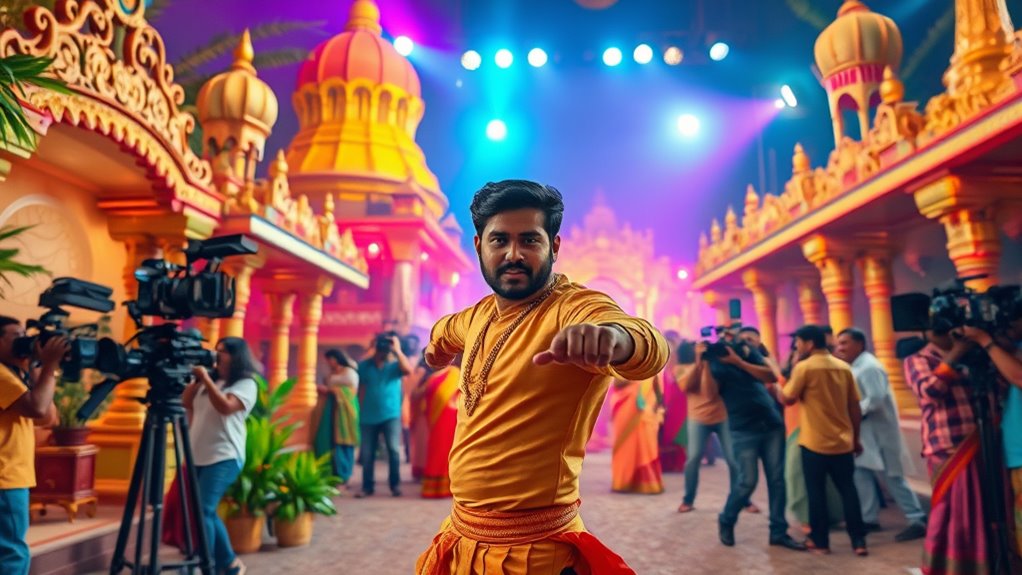Many South Indian blockbusters have been successfully remade in Bollywood, like Vikramarkudu becoming Rowdy Rathore and Singam transforming into Singham. Others include the Malayalam hit Bodyguard, Telugu series Baaghi, and the Tamil film Kabir Singh, which gained huge popularity. These remakes often adapt cultural nuances while maintaining core stories. If you keep exploring, you’ll discover more fascinating examples and how these remakes impact Indian cinema.
Key Takeaways
- Several South Indian blockbusters like Vikramarkudu, Singam, and Vikram Vedha have been successfully remade into Bollywood films.
- Bollywood adaptations often retain core themes while incorporating cultural and stylistic changes for regional appeal.
- Remakes like Ghajini and Kabir Singh significantly boosted actors’ careers and expanded their popularity.
- Telugu and Tamil films such as Baaghi series and Shehzaada have been remade to cater to broader Hindi-speaking audiences.
- These remakes demonstrate South Indian cinema’s strong influence on Bollywood’s commercial success and storytelling trends.
Rowdy Rathore: From Vikramarkudu to Bollywood

Have you ever wondered how a Telugu blockbuster like Vikramarkudu made its way to Bollywood? The answer lies in the film’s massive success, which inspired a Hindi remake titled Rowdy Rathore in 2012. Directed by Prabhu Deva, and produced by Sanjay Leela Bhansali and Ronnie Screwvala, the remake starred Akshay Kumar and Sonakshi Sinha. It performed well at the box office and resonated with Hindi audiences, thanks to its high-energy masala entertainment. While Vikramarkudu outperformed its remake slightly in overall returns, both films enjoyed strong fan followings. The remake’s success showcased the growing influence of South Indian cinema on Bollywood, highlighting how compelling stories can transcend linguistic and cultural boundaries to captivate diverse audiences.
Bodyguard: Malayalam Hit Reimagined

The 2010 Malayalam film “Bodyguard” became a hit thanks to its engaging blend of romance and comedy, capturing audiences across Kerala and beyond. When the film was remade in Hindi in 2011, it kept the core story but added more action, appealing to a broader audience. Directed by Siddique, the remake stars Salman Khan as Lovely, the protective yet charming bodyguard. The film’s success at the box office made it one of 2011’s top earners, boosting Salman Khan’s star power and popularizing Bollywood’s action-comedy mix. The film’s vibrant visuals, catchy soundtrack, and clever marketing helped it resonate with viewers. Its cultural impact crosses language barriers, reflecting the seamless exchange between South Indian cinema and Bollywood. Additionally, the remake incorporated innovations in automation to streamline production and marketing efforts, contributing to its widespread popularity. This blending of cinematic styles underscores the importance of visual storytelling techniques in reaching diverse audiences. The film also benefited from advanced film technology, which enhanced its overall production quality and viewer experience. Furthermore, integrating targeted marketing strategies helped increase audience engagement and expand its reach globally.
Singam: Tamil Action Turned Blockbuster

You see, Singam’s raw Tamil action and patriotic spirit made it a massive hit, capturing audiences’ attention with its intense storytelling. When Bollywood adapted it as Singham, the film retained that appeal while adding local flavor, turning it into a blockbuster. This success shows how powerful Tamil action films can be when reimagined for a wider audience. The film’s success also paved the way for several other South Indian films to be remade in Hindi, demonstrating the growing influence of regional cinema on Bollywood. Additionally, the cultural adaptation process ensures that the core themes resonate with diverse audiences, further boosting their popularity. Understanding regional film remakes is essential in appreciating how cultural nuances are incorporated to appeal to different demographics. In regions where Halloween is embraced, local festivals often incorporate themed elements, influencing how films and entertainment are adapted across cultures. Recognizing the cultural significance of names helps filmmakers tailor remakes that connect deeply with regional viewers. Moreover, the increasing use of crossover narratives in remakes exemplifies how storytelling techniques are shared across industries to enhance viewer engagement.
Tamil Action Appeal
What makes Singam stand out as a Tamil action film that turned into a blockbuster? It’s the perfect blend of gritty action, authentic village settings, and a relatable hero fighting for justice. The film’s intense confrontations, driven by Suriya’s powerful performance, kept audiences on the edge of their seats. Hari’s direction brought raw energy and realism to every scene, making it a benchmark for Tamil police dramas. Its high rewatch value comes from memorable action sequences and a story rooted in honesty and courage. The film’s cultural resonance and portrayal of a sincere cop resonated deeply with viewers, elevating it beyond typical masala fare. Singam’s appeal lies in its authentic portrayal of heroism, making it a timeless favorite in Tamil cinema. Additionally, its success inspired numerous remakes and sequels, demonstrating the story’s widespread appeal. Its realism and cultural authenticity contributed significantly to its popularity, setting a standard for future Tamil action films. Furthermore, the film’s storytelling style effectively combined emotional depth with high-octane sequences, enhancing its overall impact. Incorporating data-driven marketing strategies could further expand its reach and influence in various markets. Moreover, the film’s cultural authenticity helped it resonate with a broad audience, both domestically and internationally.
Bollywood Adaptation Success
Bollywood’s knack for transforming regional hits into nationwide blockbusters shines brightly with the success of “Singham.” When the Tamil action film “Singam” captivated audiences with its gritty realism and relatable hero, Bollywood producers saw an opportunity to adapt its core elements for a broader audience. The 2011 remake, directed by Rohit Shetty and starring Ajay Devgn, stayed true to the original’s intense action and strong storytelling while tailoring dialogues, cultural references, and settings for North Indian viewers. Its high-octane sequences and mass hero appeal resonated widely, leading to blockbuster status and spawning sequels that expanded the franchise. The film’s commercial success confirmed that South Indian stories, when adapted effectively, can dominate the Hindi box office and set a blueprint for future remakes. Understanding Best Anime Movies can also provide insights into how diverse storytelling styles are adapted across cultures, much like Bollywood’s remakes.
Ghajini: The Indian Remake of a Tamil Classic

The storyline in the Hindi *Ghajini* stays true to the Tamil original, but subtle differences influence how the story unfolds for audiences. This adaptation also impacted the careers of the lead actors, with Aamir Khan’s performance elevating his status and bringing widespread attention to remakes. How these changes shaped perceptions of the film and its stars is key to understanding its lasting legacy. Additionally, understanding the relationship dynamics behind the film’s success highlights how emotional resonance can enhance viewer engagement. Recognizing the importance of cultural context in adaptations can further explain audience reception and the film’s impact. Considering the influence of AI safety measures in the film industry, such as content moderation and ethical storytelling, can further enrich the understanding of modern cinematic adaptations. Furthermore, the integration of aesthetic wall organization techniques in set design can subtly influence viewers’ perceptions and the overall visual appeal of film scenes. An appreciation of adaptation strategies can reveal how filmmakers modify stories to resonate with diverse audiences across different regions.
Storyline Adaptation Differences
Have you ever noticed how remakes often stay true to their originals while making subtle changes to suit new audiences? In *Ghajini*, the Hindi version closely follows the Tamil plot—both focus on a man with memory loss seeking revenge for his fiancée’s murder. The core story remains, but the climax was rewritten for a fresh impact, reflecting Bollywood’s style. You’ll see differences in tone, with Aamir Khan’s emotional depth contrasting Suriya’s performance, and the addition of Bollywood-style songs and dance sequences. Additionally, fraud detection techniques were subtly incorporated into the adaptation process to ensure the story’s integrity in the new cultural context. These adaptation strategies help balance respect for the original with the expectations of the Hindi audience. Moreover, understanding audience preferences is crucial for successful remakes, which often involves analyzing regional cinematic tastes and storytelling styles. The story’s core remains consistent, with minor plot tweaks. The climax was reworked for a more dramatic, satisfying ending. Emotional textures differ based on actors’ portrayals. Bollywood added song sequences, enhancing commercial appeal. The narrative flow retains the original’s essence but adapts to cultural preferences, demonstrating the importance of cultural adaptation in cross-regional remakes. Additionally, employing tuning techniques can enhance the emotional impact of such adaptations, making them more resonant with the target audience.
Impact on Careers
Remakes like Ghajini can considerably boost the careers of those involved by showcasing their talent to broader audiences. For you, this film served as a launchpad and validation. Suriya’s performance in the Tamil Ghajini solidified his reputation as a versatile star, and his involvement in the Hindi remake enhanced his industry recognition. Aamir Khan’s first remake venture marked a significant career milestone, earning him awards and nominations, and expanding his reach beyond Bollywood. Asin’s dual performances increased her visibility and opened doors in Hindi cinema. The films’ commercial success demonstrated the profitability of remaking South Indian hits, attracting industry attention and opportunities. Overall, Ghajini’s success helped the key players elevate their status and secure more prominent roles across Indian cinema. Incorporating career development strategies can further amplify the benefits gained from such remakes.
Kabir Singh: The Telugu Original’s Bollywood Journey

How did a gritty Telugu film like Arjun Reddy transform into the blockbuster Bollywood hit Kabir Singh? You see, director Sandeep Reddy Vanga recreated his raw, emotionally intense story for Hindi audiences, making key changes to appeal nationwide. The film, starring Shahid Kapoor, expanded the character’s dramatization and added a more stylized look to reach a broader crowd. It quickly gained popularity, grossing over ₹340 crore globally, far surpassing the original’s ₹51 crore. The movie’s themes of passion, heartbreak, and toxic masculinity struck a chord, even amid controversy. Its success underscored Bollywood’s hunger for regional stories with universal appeal, transforming a regional hit into a pan-India phenomenon.
- Raw, emotional storytelling with regional authenticity
- Major star power: Shahid Kapoor’s intense performance
- Broader, more dramatized character portrayal
- Significant box office success, surpassing original
- Controversial themes fueling debate and buzz
Vikram Vedha: Tamil Thriller in Hindi

Vikram Vedha, a gripping Tamil neo-noir thriller, masterfully explores the moral gray areas through its intricate characters and compelling storytelling. In the Hindi remake, you see Hrithik Roshan as Vedha and Saif Ali Khan as Vikram, bringing fresh energy to the complex story. Both versions highlight neo-noir elements, emphasizing moral ambiguity and challenging traditional notions of good and evil. As you watch, you notice Vikram’s black-and-white worldview clash with Vedha’s understanding of life’s shades of gray. The film’s themes of justice, morality, and redemption resonate deeply, reflecting Indian storytelling’s mythological roots. Despite mixed reviews, the film’s focus on nuanced characters and moral dilemmas makes it a significant example of South Indian stories crossing into Bollywood.
Baaghi Series: Telugu Films in Hindi

You’ll notice that the Baaghi series draws heavily from Telugu action films, showcasing their influence in Bollywood. Tiger Shroff’s debut in the first film marked a major turning point, establishing him as a star. The series’ strong box office performance highlights how Telugu roots continue to shape Hindi cinema’s blockbuster hits.
Telugu Action Roots
- Adaptation of Telugu storylines for Hindi audiences
- Incorporation of intense action sequences inspired by South Indian cinema
- Focus on high-energy fight scenes and stunts
- Use of Telugu film themes like family and heroism
- Bollywood’s rise in action genre popularity due to these roots
Tiger Shroff’s Debut
Have you ever wondered how Bollywood embraced intense action by adapting South Indian films? Tiger Shroff’s debut in the Baaghi series marked a turning point. He stepped into the spotlight with his athleticism, bringing a fresh face to Hindi action cinema. The franchise’s success hinges on remaking regional blockbusters like Varsham, blending high-octane stunts with Bollywood flair. His debut set the tone for a series that prioritizes powerful action sequences and star-led marketing. Here’s a quick overview:
| Aspect | Details | Impact |
|---|---|---|
| Film Remake | Varsham (Telugu, 2004) | Introduced Shroff as action star |
| Shroff’s Role | Lead protagonist, action-focused | Established his star power |
| Franchise Strategy | Remake of South Indian hits | Built a cult following |
| Critical Reception | Praised for athleticism, criticized for depth | Highlighted focus on action |
This debut laid the foundation for Bollywood’s obsession with remaking regional blockbusters.
Box Office Impact
The Baaghi series demonstrates how remaking Telugu films can substantially boost box office performance in Hindi cinema. You see, each film’s rising earnings highlight the franchise’s commercial strength despite mixed reviews. Baaghi 2 grossed over ₹254 crore worldwide, showing impressive growth from the first film, Baaghi, which earned ₹129 crore. Baaghi 3, with a ₹137.57 crore haul, opened strongly at ₹17 crore and amassed ₹52.50 crore in its opening weekend. The series’ action-packed stories and remixed songs attracted audiences, even with poor critic ratings. Its success proved Telugu remakes could dominate the Hindi box office. The franchise’s star power, especially Tiger Shroff, and its ability to compete with major releases, underscore its significant market impact. Future installments are expected to maintain this momentum.
Shehzaada: Telugu Blockbuster’s Hindi Adaptation

Did the Hindi adaptation of the Telugu blockbuster Shehzaada live up to expectations? Not quite. Starring Kartik Aaryan as Bantu, the film aimed to replicate Allu Arjun’s magnetic screen presence but fell short in capturing the original’s charm. Kriti Sanon returns as the female lead, adding chemistry but unable to elevate the film’s emotional depth. The supporting cast, including Paresh Rawal and Manisha Koirala, provides solid performances, yet the plot’s emotional twists and family drama don’t resonate as powerfully. Rohit Dhawan’s direction offers moments of comedy and action, but the overall narrative feels dragged and lacks freshness. Despite strong action and comedy elements, the remake struggled to match the original’s box office success and failed to fully satisfy fans expecting a blockbuster experience.
Jersey: Telugu Sports Drama Recreated

When Gowtam Tinnanuri’s 2019 Telugu film Jersey made a heartfelt mark with its emotional storytelling and authentic sports drama, expectations ran high for the Hindi remake. You’re taken into the life of a failed cricketer in his 30s, fighting to return to the game for his child’s future. The remake, released in 2022, starred Shahid Kapoor and Mrunal Thakur, with Gowtam Tinnanuri directing again. You notice the effort to balance emotional core with cultural tweaks for Hindi audiences. Despite praise for performances, the film didn’t match the original’s success at the box office. Challenges included preserving the film’s authenticity while adapting to a different market and audience sensibilities. The high ₹80 crore budget underscored the risks involved in remaking such a heartfelt sports story.
- A focus on emotional depth and authentic sports drama
- Shahid Kapoor’s earnest performance as the lead
- Cultural adjustments to suit Hindi viewers
- Critical acclaim contrasted with modest box office results
- Challenges in capturing the original’s heartfelt essence
Sarrfira: Tamil Story in Hindi Cinema

Following the trend of Hindi remakes of acclaimed South Indian films, *Sarfira* brings the compelling story of *Soorarai Pottru* to Hindi audiences. This film, a remake of the 2021 Tamil hit that won five National Awards, stars Akshay Kumar as Vir Jagannath Mhatre, a man determined to make air travel affordable. Set amid India’s aviation and startup scenes, *Sarfira* follows his journey of overcoming societal hurdles, inspired by G.R. Gopinath’s memoir. Directed by Sudha Kongara, who also helmed the original, the film explores themes of perseverance and innovation. Released on July 12, 2024, it received mixed reviews, highlighting the challenges of translating a beloved South Indian story to Hindi. The film signifies a broader cultural exchange in Indian cinema, blending regional narratives for wider audiences.
Frequently Asked Questions
How Do Remakes Influence Original South Indian Films’ Popularity?
You might notice that remakes can boost the popularity of original South Indian films by increasing their visibility, attracting new audiences, and highlighting cultural significance. While remakes sometimes shift viewer preferences, they also create high expectations and comparisons. Overall, remakes can serve as a marketing tool, drawing attention to the original stories, but they can also overshadow the originals if not handled carefully.
What Are the Challenges in Adapting South Indian Culture for Bollywood Audiences?
When adapting South Indian culture for Bollywood audiences, you face challenges like bridging cultural differences to make stories resonate universally. You need to balance Western and Indian elements carefully while respecting original creators’ rights. Sensitivity to cultural nuances is essential to avoid misrepresentation. Meeting audience expectations, maintaining authenticity, and capturing emotional depth are crucial, all while ensuring the adaptation remains engaging and true to the original’s spirit.
Do Remakes Typically Stay True to the Original Story or Add New Elements?
Imagine you’re watching a remake; usually, it stays true to the original story, but Bollywood often spices things up. You’ll see added subplots, emotional depth, or changes in climax to suit local tastes. The core plot remains recognizable, but filmmakers tweak characters, music, and action to connect better with Hindi audiences. So, while the foundation stays intact, new elements are often woven in to keep the story fresh and engaging.
How Does Star Casting Impact the Success of South Indian Remakes?
You might think star casting guarantees success, but it doesn’t always. When Bollywood stars are cast in remakes, they attract attention and generate buzz, yet they can also overshadow the story or feel miscast. While big names can boost box office potential, audiences now crave substance over celebrity. If the star’s performance doesn’t resonate or match the original’s authenticity, the remake might underperform, regardless of star power.
Are Remakes More Profitable Than Original Bollywood Films?
Think of remakes as a golden ticket—often more profitable than original Bollywood films. You see, remakes like *Kabir Singh* and *Simmba* outperform their originals at the box office, reaching wider audiences and generating higher earnings. The familiarity of the story and cultural relevance help them strike a chord, making them a safe bet for producers. So, yes, remakes tend to be more profitable thanks to their proven appeal.
Conclusion
So, next time you’re craving a Bollywood blockbuster, remember it might just be a South Indian classic in disguise. Who needs originality when you can have a familiar story with a dash of Hindi masala? After all, why bother with fresh ideas when remaking hits is so much easier? Sit back, enjoy the familiar, and wonder how many more South Indian gems will find their Bollywood “remake” in the future.









